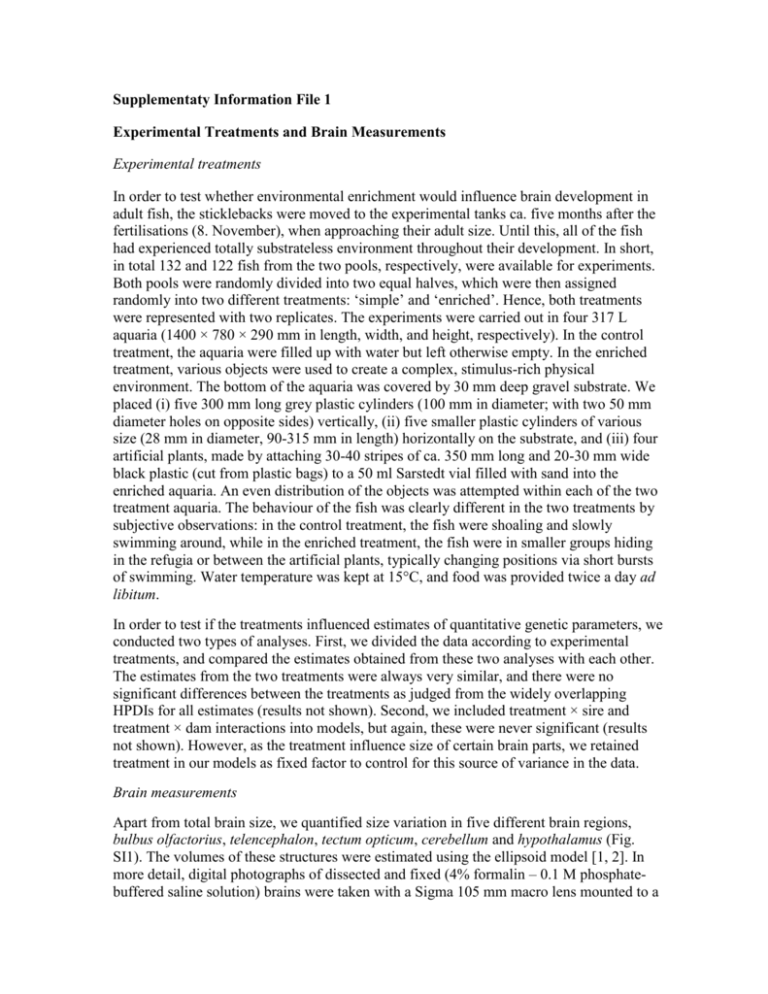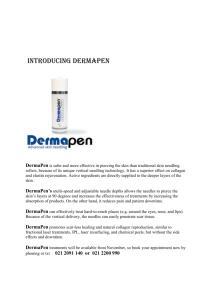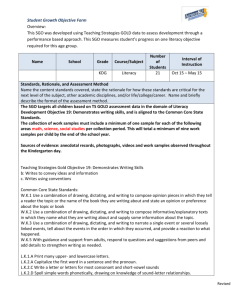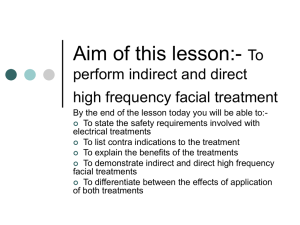Supplementaty Information File 1 Experimental Treatments and
advertisement

Supplementaty Information File 1 Experimental Treatments and Brain Measurements Experimental treatments In order to test whether environmental enrichment would influence brain development in adult fish, the sticklebacks were moved to the experimental tanks ca. five months after the fertilisations (8. November), when approaching their adult size. Until this, all of the fish had experienced totally substrateless environment throughout their development. In short, in total 132 and 122 fish from the two pools, respectively, were available for experiments. Both pools were randomly divided into two equal halves, which were then assigned randomly into two different treatments: ‘simple’ and ‘enriched’. Hence, both treatments were represented with two replicates. The experiments were carried out in four 317 L aquaria (1400 × 780 × 290 mm in length, width, and height, respectively). In the control treatment, the aquaria were filled up with water but left otherwise empty. In the enriched treatment, various objects were used to create a complex, stimulus-rich physical environment. The bottom of the aquaria was covered by 30 mm deep gravel substrate. We placed (i) five 300 mm long grey plastic cylinders (100 mm in diameter; with two 50 mm diameter holes on opposite sides) vertically, (ii) five smaller plastic cylinders of various size (28 mm in diameter, 90-315 mm in length) horizontally on the substrate, and (iii) four artificial plants, made by attaching 30-40 stripes of ca. 350 mm long and 20-30 mm wide black plastic (cut from plastic bags) to a 50 ml Sarstedt vial filled with sand into the enriched aquaria. An even distribution of the objects was attempted within each of the two treatment aquaria. The behaviour of the fish was clearly different in the two treatments by subjective observations: in the control treatment, the fish were shoaling and slowly swimming around, while in the enriched treatment, the fish were in smaller groups hiding in the refugia or between the artificial plants, typically changing positions via short bursts of swimming. Water temperature was kept at 15°C, and food was provided twice a day ad libitum. In order to test if the treatments influenced estimates of quantitative genetic parameters, we conducted two types of analyses. First, we divided the data according to experimental treatments, and compared the estimates obtained from these two analyses with each other. The estimates from the two treatments were always very similar, and there were no significant differences between the treatments as judged from the widely overlapping HPDIs for all estimates (results not shown). Second, we included treatment × sire and treatment × dam interactions into models, but again, these were never significant (results not shown). However, as the treatment influence size of certain brain parts, we retained treatment in our models as fixed factor to control for this source of variance in the data. Brain measurements Apart from total brain size, we quantified size variation in five different brain regions, bulbus olfactorius, telencephalon, tectum opticum, cerebellum and hypothalamus (Fig. SI1). The volumes of these structures were estimated using the ellipsoid model [1, 2]. In more detail, digital photographs of dissected and fixed (4% formalin – 0.1 M phosphatebuffered saline solution) brains were taken with a Sigma 105 mm macro lens mounted to a Nikon D80 digital camera. Digital images were analysed in tps.Dig 1.37 software [3]. For each brain region (Fig. SI1), we quantified the length, height and depth as illustrated in Figs. SI2 A-C, and used this information to calculate the volume of brain regions and total brain using the ellipsoid model [1, 2]. Lengths were measured from the lateral view photographs and defined as the greatest distance enclosed by the given structure. Heights were measured from the lateral view images and defined as the greatest distance enclosed by the given structure perpendicular to the length measure. Widths were measured from the dorsal (bulbus olfactorius, telencephalon, tectum opticum, cerebellum) or ventral (hypothalamus) view images and defined as the greatest distance enclosed perpendicular to the estimated projection of the brain. For the paired structures, we measured both structures and used the average for the volume estimates. Length and height of the total brain was measured as depicted in Fig. SI2D. Length was defined as the distance between the tip of bulbus olfactorius and the end of cerebellum parallel to the estimated projection of the brain. Height was defined as the greatest distance enclosed across the tectum opticum perpendicular to the length measurement. Width of the total brain was represented by the maximal width, practically being equal to the double tectum opticum measure (Fig. SI2A). Repeatabilities of brain region and total brain volume estimates were obtained by repeating the full measurement process three times (see text and Table SI1). As an additional measure of brain size we weighted the brains. For this process, we need to cut the remnants of medulla oblongata and different nerves. A brain prepared for weighting is shown from the lateral side in Fig. SI2E. Repeatability of the brain mass was 0.988 (SE = 0.0025; F64,130 = 254.59, P < 0.001). Note that all photographs Figs. SI1 and SI2 were taken from the same brain. References 1. Huber R, Staaden MJ, van Kaufman LS, Liem KF. 1997 Microhabitat use, trophic patterns, and the evolution of brain structure in African cichlids. Brain Behav. Evol. 50, 167–182. 2. Pollen AA, Dobberfuhl AP, Scace J, Igulu MM, Renn SCP, Shumway CA, Hofmann HA. 2007 Environmental complexity and social organization sculpt the brain in Lake Tanganyikan cichlid fish. Brain Behav. Evol. 70, 21–39. 3. Rohlf FJ. 2002 tpsDig, digitize landmarks and outlines, ver. 1.37. Stony Brook: Dept. Ecol. Evol., State University of New York. Table SI1. Measurement error (ME) and repeatability (R) of the analysed traits. Repeatability is based on two repeated measures of 20 individual brains. S.E. = standard error. Trait ME R SE F P Bulbus olfactorius 0.12 0.88 0.04 22.35 <0.001 Cerebellum Hypothalamus Tectum opticum Telencephalon Brain 0.24 0.08 0.09 0.08 0.76 0.92 0.91 0.92 0.08 0.03 0.04 0.03 10.32 33.76 29.66 35.72 <0.001 <0.001 <0.001 <0.001 0.03 0.97 0.01 106.74 <0.001 0.05 0.95 0.02 58.46 <0.001 Brain (sum of the parts) Fig. SI1 An image depicting different brain regions analysed in this study. Upper row shows dorsal (left) and ventral (right) views of the same brain, and the figure below is the same brain lateral view. Fig. SI2. A picture depicting how the lengths, widths and depths of different brain regions (A to C) and total brain size (D) were measured. A. the dorsal view of stickleback brain showing the width measures of (from left to right) cerebellum, tectum opticum, telencephalon and bulbus olfactorius, B. the ventral view of stickleback brain showing the width measure of hypothalamus, C. the lateral view of stickleback brain showing the height (lines close to vertical) and length (lines close to horizontal) measures of (from left to right, upper regions) cerebellum, tectum opticum, telencephalon, bulbus olfactorius and hypothalamus (lower region), D. the lateral view of stickleback brain showing the height (line close to vertical) and length (line close to horizontal) measures of total brain. E. An image of (the same) brain showing it in a shape it was weighed. See text for further explanations.



